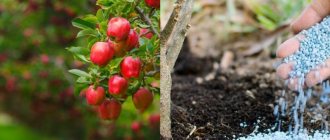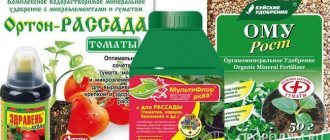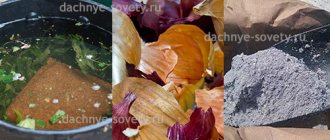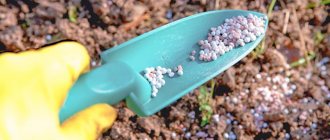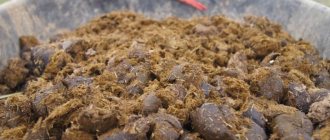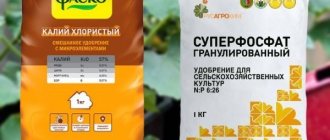Why do you need autumn feeding?
Not every garden plot in the middle zone can boast of fertile soil. In addition, even if rose bushes are planted in good soil, it will still deplete over time. During the spring and summer flowering period, the rose very actively consumes nutrients from the soil - and accordingly, by autumn there are very few of them left.
Autumn feeding allows you to:
- enrich the depleted soil and supply roses with useful substances;
- strengthen the root system of the plant before going into winter dormancy;
- give the rose the strength necessary for the plant to recover, including after autumn pruning;
- strengthen the plant’s immunity to diseases and pests;
- increase the cold resistance of rose bushes and prevent them from freezing in winter.
Correctly performed autumn feeding of roses and preparation for winter contributes to the rapid growth of rose bushes in the spring - and their abundant flowering.
Important! As a rule, roses are fed twice in the fall. In the first - at the very beginning of September, and in the second - at the end of October or early November, before the arrival of cold weather.
Ways to feed roses in August and September
In August and September, the rose can be fed by root and foliar methods. In October, when the foliage has already fallen and there is a risk of frost, foliar feeding is not carried out. Only the root method is used, traditionally by embedding granules or powder into the soil.
Foliar feeding of roses in autumn
Foliar feeding is most often used as a means of treating roses with premature wilting. This method allows you to deliver nutrients to tissues as quickly as possible. The components are absorbed only by the treated plant and do not enter the soil.
Nutrient solution recipes:
- Dissolve 50 g of superphosphate in 1 liter of hot water. Fill the volume with cold water to 10 liters.
- Take 5 g of potassium monophosphate and superphosphate. Dilute in a bucket of water, strain.
- Dilute 200 g of wood ash in a bucket of warm water and leave for 3 days. Strain through cheesecloth, otherwise the sprayer nozzles will clog.
The best time for foliar feeding is morning. During the day, such fertilization will lead to sunburn of the leaves.
It is not advisable to do this feeding in the evenings. In August and September at this time it is already cool, excess water will not evaporate, and fungus may develop.
Root feeding of roses
For root feeding of roses in August or autumn, combined mineral fertilizers are often used. They can be in the form of a solution or powder (granules). The first form is used when you need to achieve a quick effect. Granules disintegrate more slowly, which is why they are most often used to store nutrients in the soil.
Popular solution for autumn feeding of roses:
- potassium sulfate - 10 g;
- boric acid - 2.5 g;
- superphosphate - 25 g.
These fertilizers are diluted in 10 liters of water and watered approximately 3 liters per bush. You can use this recipe only if you have an electronic scale: you need to measure out exactly 2.5 g of boric acid. If there is more, there is a risk of burning the roots, and this rose will die in winter.
For root feeding, you can dilute 15 g of potassium monophosphate and superphosphate in 10 liters of water. This volume is enough to fertilize five square meters of rose garden.
Root
The method is that fertilizers are applied directly to the soil near the plant in the fall. Beneficial substances are taken up by the root system - and from there they are carried further throughout the plant. Thus, the roots, stems, and leaves receive nutrition - and at the same time, very little time is spent on feeding.
Root feeding can be:
- liquid - in this case, minerals or organic matter are dissolved in water and the plant is watered with the resulting composition;
- dry - fertilizers in dry form are either placed in small grooves dug in the ground, or simply scattered over the surface and then covered with earth.
Advice! In dry and warm weather in autumn, it is recommended to water the soil after dry root feeding. If the soil is already waterlogged, then additional watering is not necessary.
Folk remedies
As part of preparing roses for winter, not only industrial but also home remedies are used for feeding. They have a particularly good effect on fertile soils, where plants receive enough nutrients and do not require large amounts of fertilizer.
Common yeast
Ordinary yeast has a beneficial effect on decorative crops. They improve soil quality and promote rapid development of rose bushes in spring. In the fall, the following remedy is used for feeding:
- About 10 g of yeast are dissolved in 10 liters of warm water.
- Add a little sugar to the liquid to start the fermentation process.
- Mix the ingredients and put the container in a warm place for a week.
After the period has passed, the prepared solution is diluted with clean water in equal proportions and the rose bushes are watered.
The yeast solution is added to the soil when watering immediately after the roses have finished flowering.
Eggshell
If there is a lack of calcium in roses, you can use eggshells for feeding. In addition to the main substance, it also contains phosphorus, potassium and iodine. The product is used in a simple way - the shell is ground into powder and sprinkled on the roses in a circle around the trunk. About 500 g of fertilizer should be used per 1 m2 of soil. The use of fertilizing is allowed for bushes older than two years.
Advice! Eggshells can emit an unpleasant odor, so it is recommended to wash and dry them first.
Fertilizing rose bushes in the fall with eggshells is useful on acidic soils
Banana peel
Banana peels contain potassium, phosphorus and calcium, so based on the peels you can prepare a nutritious fertilizer that improves the composition of the soil and strengthens the roots of rose bushes. Feeding is done as follows:
- Cut the peel into small pieces and add 1 liter of water.
- Infuse the skin for two weeks in a warm, dark place.
- Use the resulting solution to water ornamental bushes.
When planting roses in the fall, banana peels are placed directly at the bottom of the holes. The skin supplies nutrients and beneficial amino acids to the roots of the seedlings.
Spraying banana peel infusion helps protect roses from aphids
Onion peel
A whole complex of useful substances is contained in onion peels, on the basis of which you can prepare a nutritious supplement. The algorithm looks like this:
- About 20 g of purification is poured into 5 liters of warm water.
- Leave the product in a dark place for five days.
- After the period has passed, filter from the sediment at the bottom.
The finished infusion is used for spraying or for watering roses at the root.
Onion peels can be mixed with wood ash in a liquid solution or in dry form
Foliar
Foliar feeding involves spraying the upper part of the plant with a spray bottle. Most often it is used as an addition to the root method. But sometimes foliar feeding can be used separately - for example, if useful substances have already been added to the soil quite recently.
In this case, fertilizers are absorbed by the surface of the leaves. The main advantage of foliar feeding is that the effect occurs very quickly. This may be important if feeding is aimed at combating a disease.
It is necessary to fertilize the rose through the leaves only in cloudy weather, in the late afternoon, but not too late, so that the foliage has time to dry before nightfall. The nutrient solution should be slightly concentrated; rose leaves should be sprayed not only from above, but also from the bottom.
Pruning roses after flowering
Autumn pruning of roses after flowering is very important. It is imperative to prune roses for the winter. The main reason for the need for pruning is that it will make it easier to cover the bushes for the winter. This is especially important for hybrid tea varieties, as well as floribunda varieties.
The main purpose of pruning in the fall is to reduce the height of the bushes. Many gardeners advise pruning shrubs during the waning moon. It wouldn’t hurt to refer to the florist’s calendar.
Cut the shoots by about half - this way they can easily be protected from frost.
There are certain rules for pruning roses that should be strictly followed:
- cut shoots only at an angle;
- all weak shoots are removed to the base;
- use only very sharp pruning shears;
- All white sprouts should be cut out.
After trimming, the cut areas must be treated with an antiseptic. This way, harmful microorganisms will not penetrate into the tissue of the bush.
How to fertilize roses in the fall
To feed roses with fertilizers in the fall, a very wide range of useful mixtures and substances is used - both mineral and organic. But they should not be used at random, but only with a clear understanding of why this or that feeding is needed.
Organic fertilizers
The advantages of organic fertilizers are that with each of them roses receive a whole range of useful substances. In addition, the effect of fertilizing turns out to be extended over time - valuable substances continue to nourish the plant until spring.
Ash
Wood ash is a very popular fertilizer among rose bush fans. It contains primarily potassium and calcium, and both of these elements are extremely important for roses on the eve of winter.
As a rule, ash is applied under the roots of the rose bush. It can be diluted in water in the amount of 100 g per 10 liters of liquid, or you can simply scatter dry ash on the ground - about a three-liter jar of fertilizer will be needed per square meter.
Compost
Compost is an organic mixture of fallen leaves, weeds and tops obtained as a result of overheating. This mixture contains almost all the substances that roses need in the fall - potassium and phosphorus, a small amount of nitrogen and other elements. Compost is scattered near the roots of the plant in an amount of several kilograms per square meter.
An important advantage of organic fertilizer is that compost additionally acts as a heat-insulating layer and protects the roots of the bushes from hypothermia. Therefore, it is better to apply it in late autumn, just before the onset of cold weather.
Onion peel
A non-standard, but very useful fertilizer for roses is ordinary onion peel. It contains a rich vitamin complex that roses need in autumn - vitamins C and B, carotene, phytoncides. The husk not only strengthens the plants, but also helps in the fight against insect pests.
Most often, the husk is used in liquid form. For example, you can cook:
- decoction - onion skins are tightly packed into two glasses, the measured amount is poured into 10 liters of water, boiled and then left for another 4 hours;
- infusion - 0.5 kg of husk is poured into 2 liters of warm water and infused under a lid for 24 hours.
Fertilizer can be poured under the root of the rose bush, or you can spray it on the leaves of the plant if fertilizing is carried out before leaf fall.
In addition, onion peels are often added to compost to create an improved mulching mixture that can be used before the onset of winter.
Manure
Fresh manure is an excellent classic fertilizer containing a full range of macro- and microelements - nitrogen and potassium, phosphorus, iron and manganese, magnesium and boron. In order for it to bring maximum benefit to rose bushes, it is first subjected to overheating - that is, it is put into storage and waited until it turns into humus.
Rotted manure is usually used in early autumn, fertilizing the soil under the roses with several kilograms of fertilizer per square meter. Manure plays an additional role as mulch and protects the roots of the plant from frost.
Bird droppings
Bird droppings are a high nitrogen fertilizer. This means that it is undesirable to use it in the fall, at least in high doses. Nitrogen fertilizer can provoke the rose to actively grow, while in the fall it, on the contrary, needs to go into a state of rest.
If the plant is still severely lacking in nitrogen, and you need to feed the rose in the fall, then it is better to use bird droppings in early September - and in small quantities. Then the nitrogenous compounds will have time to be absorbed by the plant, and the transition to a state of winter dormancy will proceed normally.
Eggshell
Egg shells contain a lot of calcium, which is beneficial for rose bushes. This fertilizing loosens the soil and improves its structure, promotes better root ventilation, and reduces soil acidity.
Fresh shells are used both dry and as an infusion.
- In the first case, you just need to dry the shells, then crush them into small crumbs and sprinkle the soil around the rose bushes - in a volume of 1 - 2 cups per square meter.
- In the second case, the shells of 4 eggs are poured with a liter of boiling water, and then left for 5 days, stirring daily. The resulting solution is poured under the root of the rose.
Mineral fertilizers
Both at the beginning and at the end of autumn, special mineral supplements can be used to feed roses. Their effect is faster and more concentrated. Such fertilizers are especially good for combating specific problems - for example, for restoring a plant after an illness, or for purposefully enriching the soil with some substance.
Potash fertilizers for roses in autumn
Feeding with potassium is one of the most important for roses in the fall. Potassium primarily helps to increase the plant's frost resistance, strengthens the bushes' immunity to diseases and pests, enriches the soil and guarantees a large number of buds for the next year.
The following potassium preparations are mainly used for feeding.
- Potassium sulfate is one of the best potassium fertilizers for autumn. It has a strengthening effect, but does not contain chlorine, so it can be used directly in preparation for winter.
- Potassium magnesia. The additive contains 30% potassium and 10% magnesium oxide. Well suited for fertilizing in the fall, especially successfully enriches light sandy soils.
There are other drugs - potassium chloride, potassium nitrate. However, it is better to use them in the spring or on soils where roses are only planned to be planted.
Phosphorus-potassium fertilizers for roses in autumn
Another extremely useful fertilizing in the fall is done using phosphorus-potassium fertilizers. If potassium is responsible for increasing cold resistance, then phosphorus promotes the absorption of amino acids and sugars by rose bushes, and also strengthens the roots before the coming winter.
The most popular phosphorus-potassium fertilizer is simple or double superphosphate. Phosphate rock is also used for fertilizing - it is better to use it once every few years and only on slightly acidic soil.
Attention! When feeding roses in the fall with phosphorus-potassium fertilizers, it is important to follow the dosage specified by the manufacturer. On average, it is 40 - 60 g of fertilizer per square meter - granules can be embedded in the soil either dry or diluted in water.
Nitrogen
Most gardeners are keenly interested in the question of whether it is possible to use fertilizers such as urea or ammonium nitrate in the fall - in other words, nitrogen-based fertilizing.
Since nitrogen stimulates the vegetative processes of roses and promotes the rapid development of shoots and leaves, it is not recommended to use fertilizer in the fall. This is especially true for ammonium nitrate - the concentration of nitrogen in it is very high, and even if applied to the soil in early autumn, fertilizing will have a rather negative effect on roses.
It is better to use nitrogen-based mineral fertilizers in spring and summer, when roses are actively developing and it is necessary to stimulate their growth.
Complex mineral fertilizers for roses
Purchasing complex fertilizers is an excellent option for those who value their time. The manufacturer mixes the necessary components in the correct proportions at the factory. As a result, roses receive the full amount of substances necessary to prepare for winter.
There can be many options:
- Mineral fertilizer 5-M granule "Gloria" for roses. Apply by root method - granules are scattered over the surface at a rate of 50 g/square meter. Be sure to embed the granules into the soil and water them.
- "Organic Mix" for roses. A fast-acting fertilizer that converts nutrients into accessible amino acids. Prepare a solution (100 g/10 l), water it in August or September.
- "Good power" for roses. All-season fertilizer, which contains only 3% nitrogen, contains calcium, potassium, phosphorus, boron, iron and other substances.
When choosing a complex mineral fertilizer, you need to look at its composition. It is desirable that there is little nitrogen in it, and ideally that it is completely absent. Therefore, you cannot use nitroammophoska and its analogues in September.
Nitrogen stimulates the growth of green mass to the detriment of the development of the root system.
Important features of autumn feeding
Fertilizing roses in the fall requires observing several important nuances.
- It is better not to use mineral and organic nitrogen fertilizers in the fall - they can cause the rose to grow, and before the onset of winter this is not at all necessary.
- You should also be careful with manure - it contains nitrogen. It is best to scatter it under rose bushes in late summer or early autumn.
- Fertilizing is done twice in the fall - at the beginning of September and in October, shortly before the arrival of the first frost.
- The type of fertilizing must be chosen, taking into account, among other things, the condition of the soil. If autumn turns out to be rainy, it is better to prefer dry fertilizers that do not require heavy watering.
The nuances of fertilizing roses at different ages
If the soil for the rose garden was prepared correctly, then young roses are not fertilized in August and September. Typically, such an event is carried out when the bush is 2–3 years old.
Starting from 3–4 years, autumn feeding is required. Consumption rates do not depend on the age of the plant. The main thing is to follow the manufacturer’s dosage and take into account the characteristics of the soil. In autumn, all roses are fed twice. The first time is at the end of August or the first ten days of September. The second is at the end of September or October.
Regardless of the age of the bush, in the fall it is prohibited to use manure, humus and other fertilizers with a high nitrogen content. It will prevent the shoots from becoming woody and slow down the development and strengthening of roots. As a result, over the winter the rose will weaken or die completely.
Transplanting roses
It is best to replant roses in September - the first ten days of October. First of all, it is necessary to transplant bushes that, for whatever reason, are developing poorly, to a new location. New purchased roses are also planted in a suitable place in the fall. When transplanting rose bushes, you should follow certain rules:
- Choose a place on the site that is open and sunny.
- To plant roses, you must first prepare the holes. If there are a lot of bushes, make markings. A distance of 40-50 cm is made between small roses. Varieties of bush and climbing roses are planted at a distance of 1-1.5 meters between shoots. The holes are usually made in size - 50x50 cm.
- For transplantation you also need a nutrient mixture. To prepare it, take compost, peat and sand in equal quantities. You can add clay to the soil for the flower. It is recommended to add ash, bone meal and other nutritional elements to the resulting mixture.
- Before transplanting, seedlings need to be soaked. Then they are lowered into the hole, straightening the roots. After this, the hole is filled with soil and watered generously. When the water is completely absorbed into the ground, the bushes are spudded.
Important! The best time to replant roses is the end of October. First, the roots of the seedlings are shortened a little and holes of 50x50 cm are formed. The soil mixture is added to the prepared hole. After planting, roses are watered generously.
The rose should be replanted if it does not respond well to care in the warm season. You need to dig up a bush for replanting very carefully. The roots are then wrapped in natural fabric for storage or safe transportation. Before planting, the branches are cut by 2/3. A bush is placed in the prepared hole, the roots are straightened and covered with fertile soil.
How to take rose cuttings
Rose cuttings are cut as follows:
- Choose healthy mature shoots with a diameter of 4-5 mm.
- Cut them into small pieces so that each has 3-5 developed buds.
- The upper cut is made straight 2-3 cm above the upper bud, and the lower cut is made obliquely under the lower bud, so that you know which part to plant the cutting.
- For cutting, use a sharp instrument, which is disinfected with alcohol and boiling water.
Advice! When rooting a rose, there is no need to immediately remove the leaves; they will provide nutrition to the plant; only the lower leaves are removed.
Planting a rose from a cutting
After cutting, the cuttings are planted in a permanent place. This method is preferable, as the plant experiences less stress and takes root better. Autumn rooting of rose cuttings is carried out as follows:
- The cuttings are cut and treated with a root former (for example, Heteroauxin).
- Dig a hole 30 cm deep, fill 2/3 with grass and sprinkle with compost.
- The cuttings are planted at an angle of 45 degrees, leaving 1/3 of the shoot or 1-2 buds above the ground.
- Fill the hole and water it abundantly.
- How to cover rose cuttings for the winterSo that the planted cuttings survive until spring, they are covered with a plastic bottle in which several holes are made for air circulation. You can use a glass jar, then it needs to be raised slightly above ground level. Everything is sprinkled with leaves on top and covered with non-woven material. Pegs are driven in nearby to mark new plantings.
How to save rose cuttings in winter
If you plan to plant cuttings in the spring, then you need to take care of their safety in the winter. They do it like this:
- Dig a hole 15 cm deep in the garden, lay a covering woven material on the bottom, and lay cuttings without leaves on top at the same distance from each other. Pegs are driven in along the edges of the hole so as not to forget their location.
- Cover everything with the remaining cloth and sprinkle with soil.
- In the spring, when the snow melts, the cuttings are dug up and examined. On the “established” ones, callus appears - a thick growth on which roots are formed.
- The shoots are immediately planted in the cuttings or in a permanent place.
- If planting will take place in a day or more, the cuttings are placed in a container of water (it is better to add a few drops of Epin to it).
Sheltering climbing roses for the winter
Flexible thin lashes of small-flowered ramblers in the south do not require additional shelter. In other regions they are tied, having first been removed from the trellis. Lay on a flooring made of boards or foam plastic in a ring. Insulate with material or pine branches. You can make a low frame and stretch 2-3 layers of spunbond onto it.
Climbers have problems wintering. It is difficult to bend large brittle lashes - they are accustomed to a horizontal position for several weeks, gradually bending them lower. Having reached the maximum horizontal position, they are stapled to the ground, after which they are covered - with or without a frame.
Share
Differences in autumn care for the “queen of flowers”
During spring and summer, all flower growers help rose bushes actively grow green mass and bloom profusely. But with the arrival of autumn, agrotechnical measures for caring for these flowers change radically - now you need to prepare these flowering perennials for dormancy and the cold season.
To do this, measures should be taken to inhibit the growth of the vegetative mass.
In autumn, these shrubs undergo the following changes:
- shoots become woody;
- shoot growth and bud formation practically stop;
- the root system accumulates nutrients and strengthens it;
- metabolic processes in the underground and aboveground parts of the bushes slow down.
Caring for roses in September - video
These processes are inherent in nature - this is how the bushes prepare for the upcoming winter “hibernation”. And all activities for caring for roses in the fall should be carried out taking into account these features.
Tips for fertilizing
When applying fertilizer for roses in the fall, you must adhere to several important rules:
- add dry or liquid fertilizers only to moist soil;
- spray and water roses with nutrient solutions in cloudy weather, in the evening or early in the morning, while there is no bright sun;
- do not fertilize at negative air temperatures;
- Do not apply fertilizers in excess quantities - this is harmful for ornamental crops.
Typically, nutrient solutions for spraying are prepared less concentrated than for watering, so as not to burn the leaves of the plants.

